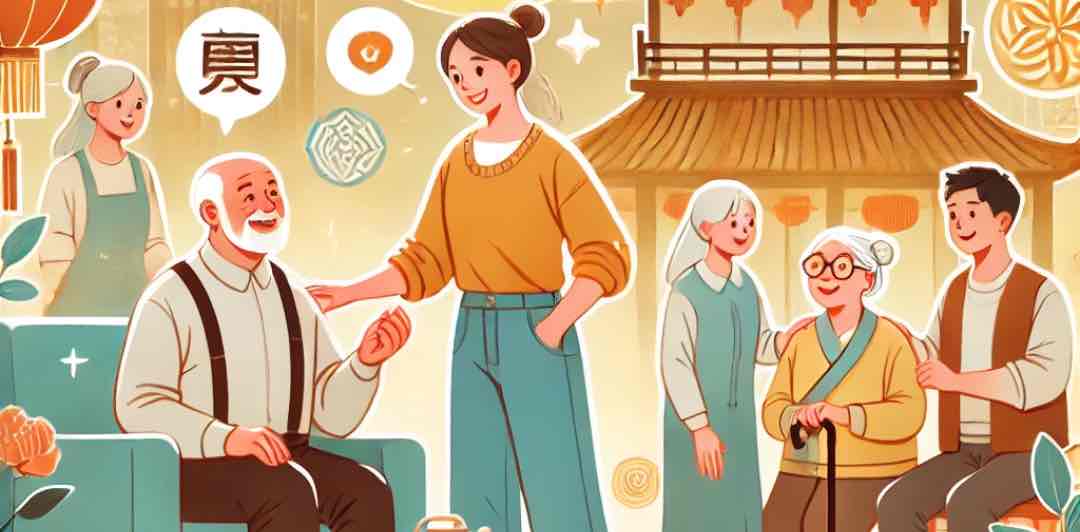
Today is the third day of the Chinese New Year. First of all, I wish you a happy new year! I wonder if young students have been urged to have children and get married.
Today we are going to talk about the topic of elderly care. This issue has suddenly become the focus of the whole nation. Now not only friends in their 50s and 60s are concerned, but even many friends in their 30s and 40s are also concerned.
On December 30, 2024, the Central Committee of the Communist Party of China and the State Council issued the “Opinions on Deepening the Reform and Development of Elderly Care Services”. In August 2024, the ninth special study of the State Council was themed “Promoting the Coordinated Development of Elderly Care and Elderly Care Industry”. Let’s analyze the wording of the country here. The elderly care industry means that the state will provide more guarantees, and the elderly care industry means that enterprises will provide more market services. Moreover, the country is vigorously encouraging more young people to join the elderly care industry.
This signal is very interesting. Because it first solves the elderly care problem, and secondly, it also solves the employment problem, and the deeper essence behind it is a problem of wealth redistribution. You may not understand what I said, don’t worry, I will give you a detailed analysis later. In fact, in my opinion, the silver economy is one of the largest domestic demands in China in the future. Therefore, this lecture is worth your careful listening.
The fundamental logic of promoting young people to invest in the elderly care industry
First of all, why does the country want to promote young people to invest in the elderly care industry?
On the one hand, the demand for elderly care is large and the burden is heavy, which we all know.
Since the founding of New China, there have been two waves of fertility peaks. The first wave was from 1950 to 1957, with a total of 150 million people born in 7 years. The second wave was from 1962 to 1973, with a total of 250 million people born in 11 years.
The 400 million people born in these two waves of fertility peaks will soon enter the aging stage now and in the future, and the demand for elderly care will increase sharply. If we rely entirely on the state for elderly care, the pressure will be very great and it will be difficult to fully meet the demand. In my opinion, this is not only a social problem, but also an economic problem.
On the other hand, young people can’t find jobs.
Since 2024, the youth unemployment rate has remained at a high level of more than 15%, and this is the data after excluding postgraduate entrance examinations, civil service examinations, and flexible employment. From 2024 to 2033, more than 12 million college graduates will enter the job market every year, but the number of jobs will not increase that much.
Based on this, I judge that young people will continue to face employment pressure in the next few years. Like the elderly care issue, this is not only a social problem, but also an economic problem.
You see, on the one hand, the elderly have elderly care needs and are burdened; on the other hand, young people are not easy to find jobs and are also anxious.
So the policy came out – vigorously develop the elderly care industry.
And before that, various places have already taken action. For example, Shanghai proposed to train 80,000 elderly care workers by 2027, giving priority to young employment. Liaoning, Guizhou, Chongqing, Inner Mongolia, Hebei, Guangxi, Shanxi and other provinces have also proposed to build multiple batches of elderly care service talents to allow young people to join the elderly care industry. You see, the localities are still very smart and can easily see opportunities.
In my opinion, the country’s policy of vigorously developing the elderly care industry and the corresponding series of actions imply two signals:
The first signal is to help the elderly solve the elderly care problem first, and to help young people solve the employment problem second.
You may have heard that China has a “9073” pension tradition, that is, 90% of the elderly prefer to live at home, 7% choose community care, and only 3% go to institutions. In this case, vigorously promoting the industrialization of pension and encouraging young people to go to the pension industry is more about solving the employment problems of young people.
The second signal is that this is a measure of wealth redistribution.
Now, many elderly people have enough savings and monthly pensions, and their actual consumption capacity is very strong, but their consumption willingness and demand are not much. If the money is not spent, the wealth will not circulate. By developing the pension industry, the country can make the money of the elderly flow, flow into the real economy, and even flow into the hands of young people, so as to achieve the purpose of activating the economy.
Simply put, the fundamental logic behind the silver economy is to allow more pension enterprises to appear in society, enterprises to hire young people to provide pension services for the elderly, the elderly use the pension issued by the state to pay pension fees to enterprises, and the enterprises then pay wages to young people.
In this way, the elderly can enjoy the elderly care services, the young people can find jobs, and the two major problems of elderly care and employment can be alleviated; the elderly’s pensions are spent, the young people make money, and the economic cycle is running.
Practical practices that can be used for reference
At this time, some readers will ask, if according to the “9073” tradition, 90% of the elderly are at home for elderly care, and they do not come to institutions, how to develop the elderly care industry?
Here we can learn from Japan’s practices. Japan is now the country with the deepest aging in the world, and the proportion of the elderly population in the total population will reach 30% in 2030. Japan has been exploring the industrialization of elderly care since the 1980s, and many practices are now very mature.
So how did Japan do it specifically? Let’s talk about the three core directions just mentioned, home elderly care, community elderly care, and institutional elderly care.
In terms of home elderly care. Japan has created a chain of compliant clinics to provide home medical care, home nursing, home physical examinations and other services for elderly people who live at home. The elderly only need to pay 10% of the cost, and the rest of the cost is paid by the national nursing insurance and nursing insurance. Initially, the proportion of elderly people who received door-to-door services was less than 5%. After more than ten years of development, more than 75% of the elderly have begun to receive door-to-door services.
In terms of community elderly care. Japan has created elderly care real estate, elderly care apartments, and three-generation housing for the elderly. The housing and community design will first undergo “aging-friendly” transformation, and then be provided to active elderly people, that is, elderly people with mobility, in the form of leasing. Each building will be equipped with one or two service personnel to provide professional services for the elderly. Moreover, the rental and service fees of this kind of elderly care real estate are not high, which is also a very cost-effective choice for the elderly.
As for institutional elderly care. Japanese companies make profits by cooperating with the government for long-term care insurance. Long-term care insurance mainly provides nursing services for the elderly. Individuals need to pay about 10% to 30% of the actual nursing costs, and the rest is covered by insurance. Japanese elderly care institutions have very strict requirements for services, and the elderly must feel the happiness of being served. Therefore, the proportion of elderly people going to elderly care institutions in Japan is far higher than that in our country. Objectively speaking, I think our country is not developing well in the field of institutional elderly care, and it can be said that there are many difficulties. Data shows that more than 80% of nursing homes are currently in continuous losses, and the industry is about to be reshuffled.
So what experience and inspiration can relevant practitioners in the elderly care industry get from Japan?
First, if you are a practitioner of home-based elderly care, you must provide more refined and diversified services. For example, provide medical services to the elderly with underlying diseases and health care services to the elderly with health needs. After all, the elderly care problems of hundreds of millions of people cannot be solved by a formula. Only when the service is refined enough can you really get this wave of dividends.
Second, if you are involved in community elderly care and are engaged in “aging-friendly” transformation work, you have to pay attention to the most cutting-edge “aging-friendly” products at the moment. For example, introduce advanced aging-friendly smart products from Japan, Europe and other countries. In addition, products such as nursing robots are also a technological direction strongly supported by the country. This is bound to be a bonus track, and you can also consider these companies when choosing a career.
Third, if you are a practitioner of elderly care institutions, you must form close cooperation with hospitals to form an integrated service system of medical care, nursing care and nursing. For the elderly, any service that shortens the medical process, reduces medical costs, and improves medical convenience is the most cost-effective service and the service that can impress the elderly the most.
China is now also trying to learn from Japan’s experience. In the next ten or even twenty years, the scale of China’s elderly care industry and silver economy will become larger and larger, and more and more young people will rely on providing elderly care services to earn income.
In other words, now is the beginning of China’s elderly care industrialization, just like the real estate industry in 2000 and the Internet industry in 2008, both are in the initial stage, and there will be a lot of industrial opportunities waiting for you to explore in the future.
Well, that’s it for today. Focus on politics and economy, and make light of heavy tasks. Personal perspective, for reference only. I am Ma Jiangbo, see you next time.
Further study:
1. “Opinions of the General Office of the State Council on Developing the Silver Economy and Improving the Welfare of the Elderly”:
https://www.gov.cn/zhengce/content/202401/content_6926087.htm
2. “Opinions of the CPC Central Committee and the State Council on Deepening the Reform and Development of Elderly Care Services”:
https://www.gov.cn/zhengce/202501/content_6996775.htm
3. The State Council issued the “National Medium- and Long-Term Plan for Actively Responding to Population Aging”:
https://www.gov.cn/zhengce/2019-11/21/content_5454347.htm
4. Notice on the issuance of the “Shanghai Action Plan for Promoting the Construction of Elderly Care Staff (2024-2027)”:
https://mzj.sh.gov.cn/MZ_zhuzhan279_0-2-8-15-55-231/20241122/73b1c1dcf0024923a8781c7f39f5becc.html



